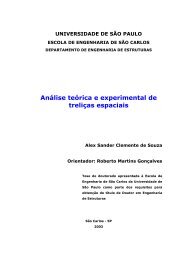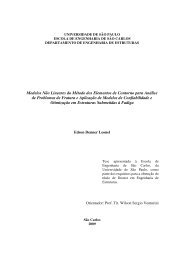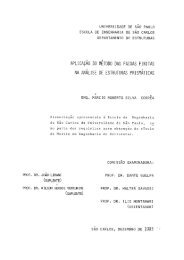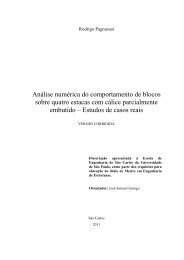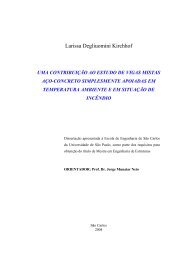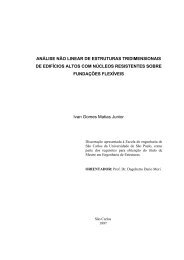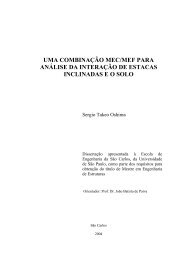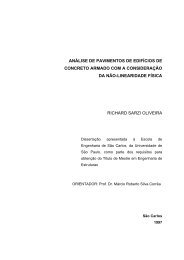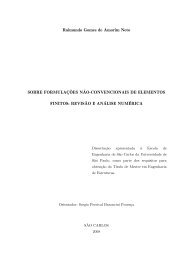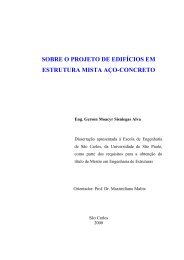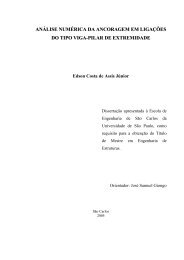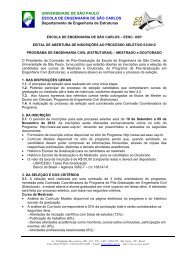o método dos elementos de contorno aplicado à ... - Sistemas SET
o método dos elementos de contorno aplicado à ... - Sistemas SET
o método dos elementos de contorno aplicado à ... - Sistemas SET
Create successful ePaper yourself
Turn your PDF publications into a flip-book with our unique Google optimized e-Paper software.
Desse modo, a segunda <strong>de</strong>rivada po<strong>de</strong> ser expressa por:<br />
∂ ∂<br />
w, ij =<br />
∂ ∂θ θ<br />
r r ⎛<br />
⎞<br />
⎜ , i+ , i⎟<br />
⎝<br />
⎠<br />
∂ ∂<br />
∂ ∂θ θ<br />
w<br />
r r<br />
⎛ w ⎞<br />
⎜ , j+ , j⎟<br />
(i, j = 1,2) (2.31)<br />
⎝<br />
⎠<br />
Desenvolvendo-se as <strong>de</strong>rivadas, obtém-se:<br />
∂w<br />
⎛ ∂r,<br />
2<br />
j ⎞ ∂ w<br />
( r r ) ⎜ , i ( r, i θ, j r,<br />
j θ,<br />
i)<br />
2<br />
∂ w<br />
w,<br />
ij = , i , j +<br />
2<br />
∂r<br />
∂r<br />
⎝<br />
( θ, i θ,<br />
j)<br />
∂θ θ<br />
2<br />
∂ w ∂w<br />
⎛ ∂θ ∂θ<br />
+ + ⎜ +<br />
2<br />
∂θ<br />
∂θ ⎝ ∂r<br />
∂<br />
r<br />
, j ,<br />
, i<br />
r<br />
⎟ + + +<br />
⎠ ∂∂θ r<br />
j<br />
22<br />
⎞<br />
θ,<br />
⎟ i<br />
(2.32)<br />
⎠<br />
Para os casos em que o problema apresenta simetria em relação <strong>à</strong> origem do sistema<br />
<strong>de</strong> coor<strong>de</strong>nadas, como ocorre no problema fundamental <strong>de</strong> placas, o <strong>de</strong>slocamento w é<br />
função apenas <strong>de</strong> r, já que não varia com θ. Nesse caso, consi<strong>de</strong>rando-se as equações (2.27)<br />
e (2.28), w, ij é dada por:<br />
2<br />
dw ⎛ ∂r,<br />
j ⎞ dw<br />
( r r ) ⎜ , 2 ( r, r,<br />
)<br />
2<br />
dw<br />
dw ⎛ t i ⎞<br />
w,<br />
ij = , i , j +<br />
i⎟ 2<br />
θ = i j + ⎜ t j ⎟ (2.33)<br />
dr<br />
dr ⎝ ∂θ ⎠ dr<br />
dr ⎝ r ⎠<br />
Assim, a partir da equação (2.33), po<strong>de</strong>-se <strong>de</strong>finir o operador diferencial <strong>de</strong> segunda<br />
or<strong>de</strong>m como sendo:<br />
∂<br />
∂x ∂x<br />
d 1<br />
( r i r j) 2 ( i j)<br />
dr r tt<br />
d<br />
= , , +<br />
(2.34)<br />
dr<br />
2 2<br />
i j<br />
Usando índices repeti<strong>dos</strong> em (2.34) e consi<strong>de</strong>rando-se r, k r, k = t, k t, k = 1, obtémse<br />
o operador <strong>de</strong> Laplace em coor<strong>de</strong>nadas polares, que é dado por:<br />
2 2<br />
2 ∂ d 1 d<br />
∇ = = 2 +<br />
∂X ∂X<br />
dr r dr<br />
K K<br />
(2.35)



